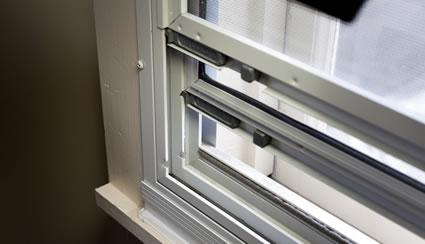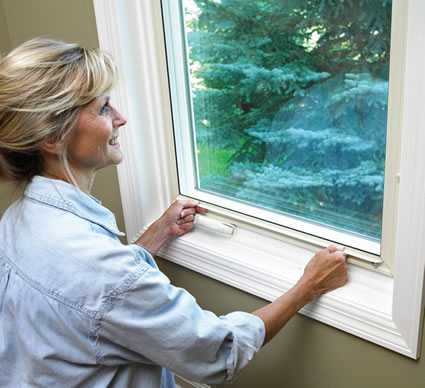Interior Panel
Description
Interior window panels function much like traditional exterior storm windows, adding an insulating layer to prevent heat loss from windows in cold weather, improving energy and comfort performance. The most common interior window panels are inexpensive, lightweight, clear plastic panels mounted in a frame sized to face-mount on the interior window casing or inset to mount on cleats installed in the window jamb. Low-e glass interior panels are also available. Interior window panels are much easier to install and remove than exterior storm windows, particularly on upper floors.
Interior window panels come in a variety of configurations to optimize performance for specific needs. They are typically installed in fall and removed in spring, but operable versions are available for year-round use. Ready-to-install panels as well as kits for do-it-yourselfers are available. Aluminum frames are most common, but some interior fixed window panels use steel, vinyl, or wood frames. Most include weatherstripping to ensure a relatively tight seal to the window casing or wall, and turnbuckles that secure the panels in place. Some steel-framed models use rubber-encased magnetic weatherstripping (like refrigerator gaskets) that hold the panels firmly in place without fasteners.
Plastic interior window panels are usually clear acrylic (e.g., Plexiglas®) or polycarbonate (e.g., Lexan®). Polycarbonate is stronger than acrylic but softer, so it scratches more easily. Acrylic used to yellow after a few years; today, ultraviolet (UV) inhibitors keep it clear for much longer. At least one interior panel is made with two layers of plastic, providing an additional air space for better insulating value (see www.windowattachments.org for product listings).
Interior glass window panels are heavier than plastic but more durable (although they can be broken), less likely to be scratched during cleaning, and available with low-emissivity (low-e) coatings that increase thermal insulation for improved energy efficiency and thermal comfort.
Terminology
The attachments described in this fact sheet are often called “interior storm windows,” but that’s a misleading term, since they really don’t offer any storm protection. Here, we will refer to them as interior window panels.

Tracked interior window panels are just like exterior storms, but permanently installed on the inside of the window. With integral screens, they adjust for ventilation. Made of glass, they are durable, clean easily, and are available with low-e coatings.
Photo: BuildingGreen
Overall Thermal Performance
Interior window panels, when properly installed and deployed, bring a window’s performance close to that of a double-
paned clear window, by reducing air leakage and increasing thermal insulation. Interior glass window panels with low-e coatings bring a window’s overall thermal performance close to the performance of a new double-paned low-e window.
When existing windows suffer from air leakage, a tight-fitting interior window panel helps prevent condensation in cold climates by reducing the moisture reaching the cold glass of the exterior prime window. As a result, condensation risk on either glazing layer is reduced. For hot humid climates, a tighter outer layer is preferable because the outer layer keeps most outdoor air and moisture from entering the air space between the layers. Condensation on the outermost glazing in a window assembly is more about obstructed view than durability.
Key Benefits
- Winter heat loss through windows reduced, comfort improved
- Condensation potential reduced with air tight panels
- Good visibility to the outdoors
- Noise control
Key Drawbacks
- Depending on installation system, may hamper egress (interior fixed panels)
- May require seasonal installation and removal, as well as storage when not in use (non-operable panels)
- May affect visibility (plastic panels)
Aesthetics
- Most, but not all, panels are relatively unobtrusive
Tips/Cautions
- Clean windows and interior panels before installing.
- For interior plastic panels, use only cleaning agents appropriate for the type of glazing; ask manufacturer for cleaning recommendations.
- Label all panels for proper re-installation and allow space for seasonal storage.

Interior window panels can be tracked (as shown) just like exterior storms, or be fixed single panels. With integral screens, they adjust for ventilation. Made of glass, they are durable, clean easily, and are available with low-e coatings. Acrylic window panels are often face-mounted magnetically or inset with flexible, pressure-mount, perimeter gasketing.
Photo: Larson Manufacturing
When To Consider
- Historic codes, covenants, or condominium association rules preclude installation of exterior storm windows.
- Additional insulation needed for windows on upper floor where installation of exterior storm windows is difficult.
- Renters are reluctant to invest in more permanent window treatments, such as exterior low-e storm windows.
- Existing windows are leaky.
- Climate is moderate or cold and additional window insulation during heating season is desirable.
- Climate is hot, and interior window panel with solar heat gain control coating reduces need for interior cooling in warm season.
- Window egress is not an issue.
When to consider this retrofit—Ownership
| x | Homeowner |
| x | Apartment Renter - Long Term |
| Apartment Renter - Short Term | |
| x | Live in a Condo |
| x | Live in a Historical District |
When to consider this retrofit—Window conditions
| x | Existing window single-glazed |
| x | Existing window double-glazed, no low-e* |
| Existing window double-glazed with low-e |
*low-emissivity coating
Recommended Installer
| x | Do it yourself |
| x | Carpenter |
| Manufacturer or supplier |
Complementary Options
- Awnings or exterior roller shades or screens for controlling unwanted solar gain
Considerations
| 1 | 2 | 3 | 4 | 5 | |
| Ease of Installation (1 = easier) |
x | ||||
| Availability (1 = more available) |
x | ||||
| Cost (1 = lower cost) | x | x |
Average Total Cost for 30- by 60-inch window
| Plastic panels | $60 |
| Low-e glass | $120 |
Digging Deeper
Energy Modeling Tools for Professionals
| x | RESFEN |
| EnergyPlus | |
| x | WINDOW 6 |
| Other |
References
“Measured Winter Performance of Storm Windows”
by Klems, J. Lawrence, Berkeley National Laboratory, 2003
